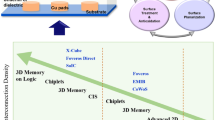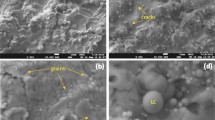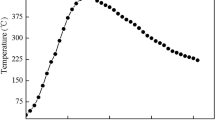Abstract
Platinum does not oxidize easily, and has slow reaction rates with Sn-based solders. Due to these two positive attributes, a single platinum layer has the potential to replace both the oxidation protection layer and the diffusion barrier layer in the underbump metallurgy of flip-chip devices. To evaluate this potential further, the dissolution rate and the wetting properties of Pt were investigated in this study. It was found that Pt did have a dissolution rate less than half that of Ni, currently the most popular barrier layer material. The wetting properties of Pt were not as good as those of Ni but were nevertheless still acceptable for industrial applications. In short, as far as the dissolution and the wetting characteristics are concerned, Pt is an effective top surface layer for use in underbump metallurgy.
Similar content being viewed by others
References
W.G. Bader. Weld. J. 48, 551 (1969).
B. Meagher, D. Schwarcz, M. Ohring. J. Mater. Sci. 31, 5479 (1996) doi:10.1007/BF01159320.
J.F. Kuhmann, C·H. Chiang, P. Harde, F. Reier, W. Oesterle, I. Urban, and A. Klein, Mater. Sci. Eng. A 242, 22 (1998) doi:10.1016/S0921-5093(97)00536-4.
B. Wiens. Z. Metallk. 91, 863 (2000).
M. Klein, B. Wiens, M. Hutter, H. Oppermann, R. Aschenbrenner, and H. Reichl, Proc. 50th Electronic Components and Technology Conf. (2000), pp. 40–45.
T.H. Kim, Y.H. Kim. JOM 56, 45 (2004) doi:10.1007/s11837-004-0111-9.
S.J. Wang, C.Y. Liu. Acta Mater. 55, 3327 (2007) doi:10.1016/j.actamat.2007.01.031.
S. Bader, W. Gust, H. Hieber. Acta Mater. 43, 329 (1995).
D. Gur, M. Bamberger. Acta Mater. 46, 4917 (1998) doi:10.1016/S1359-6454(98)00192-X.
H·K. Kim, H·K. Liou, K·N. Tu. Appl. Phys. Lett. 66, 2337 (1995) doi:10.1063/1.113975.
S·K. Kang. Scr. Metall. 14, 421 (1980) doi:10.1016/0036-9748(80)90338-5.
C.M. Liu (Master’s thesis, National Central University, Taiwan, 2000).
W.J. Zhu, J. Wang, H·S. Liu, Z.P. Jin, W·P. Gong. Mater. Sci. Eng. A 456, 109 (2007) doi:10.1016/j.msea.2006.11.117.
C.E. Ho, Y.M. Chen, C.R. Kao. J. Electron. Mater. 28, 1231 (1999) doi:10.1007/s11664-999-0162-3.
C.E. Ho, R. Zheng, G.L. Luo, A.H. Lin, C.R. Kao. J. Electron. Mater. 29, 1175 (2000) doi:10.1007/s11664-000-0010-y.
C.E. Ho, S.Y. Tsai, C.R. Kao. IEEE Trans. Adv. Packag. 24, 493 (2001) doi:10.1109/6040.982835.
C·W. Chang, C.E. Ho, S·C. Yang, C.R. Kao. J. Electron. Mater. 35, 1948 (2006) doi:10.1007/s11664-006-0298-3.
C·W. Chang, Q.P. Lee, C.E. Ho, C.R. Kao. J. Electron. Mater. 35, 366 (2006) doi:10.1007/BF02692458.
J.Y. Tsai, C·W. Chang, C.E. Ho, Y.L. Lin, C.R. Kao. J. Electron. Mater. 35, 65 (2006) doi:10.1007/s11664-006-0185-y.
J.Y. Tsai, C·W. Chang, Y.C. Shieh, Y.C. Hu, C.R. Kao. J. Electron. Mater. 34, 182 (2005) doi:10.1007/s11664-005-0231-1.
Y. Wang, K·N. Tu. Appl. Phys. Lett. 67, 1069 (1995) doi:10.1063/1.114467.
H. Baker, ASM Handbook, Vol. 3, Alloy Phase Diagrams (Metals Park, OH: ASM Intl., 1992), p. 2.347.
J.I. Lee, S·W. Chen, H.Y. Chang, C.M. Chen. J. Electron. Mater. 32, 117 (2003) doi:10.1007/s11664-003-0181-4.
H.Y. Chang, S·W. Chen, D.S·H. Wong, H·F. Hsu. J. Mater. Res. 18, 1420 (2003) doi:10.1557/JMR.2003.0195.
Author information
Authors and Affiliations
Corresponding author
Rights and permissions
About this article
Cite this article
Yang, S., Chang, W., Wang, Y. et al. Interfacial Reaction and Wetting Behavior Between Pt and Molten Solder. J. Electron. Mater. 38, 25–32 (2009). https://doi.org/10.1007/s11664-008-0541-1
Received:
Accepted:
Published:
Issue Date:
DOI: https://doi.org/10.1007/s11664-008-0541-1




